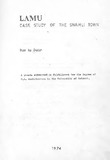| dc.description.abstract | The Swahili coast between Kismayu in the north and
the Zambezi river in the south, and many of the
islands facing it have been the locations of
important settlements. Artime trade brought
these settlements into contact with various regions
of the Indian Ocean, and exposed them to their
culture. Gradually new styles of expression began
to emerge. These are evident in all aspects of
Swahili material culture: the art, the architecture
and, not least, the towns which are the subject of
this thesis.
The thesis analyses the structure and discusses
the types and function of these towns. It does
this by focusing on the in-shore island town of
Lamu on the northern coast of Kenya. This town
is a convenient milieu for such a study because it
preserves more of its original character than any
of the other Swahili settlements. It is one of the
few existing Swahili towns that managed to survive
physical destruction by war-like tribes, commercialization
by tourism and the urban surgery of progress.
The Introduction is a brief historical background.
Against this background the three chapters of Part
One focus on Lamu town and its immediate environment.
Chapter 1-1 describes the Lamu archipelago and
the coastal stretch of Kenya north of the Tana
1-
river. It discusses the function, economy and
patterns of architecture of the towns of the area.
Chapter 1-2 focuses on the town of Lamu. It
discusses its form and traces its historical
development until the beginning of the present
century.
In Chapter 1-3 the plan of the Lamu house is
analysed in relation to patterns of behaviour and
compared to Swahili house plans of earlier dates.
Part Two draws conclusions about the Swahili town
generally. Chapter 2-1 discusses the factors that
appear to have dictated Swahili planning ideals;
Swahili concepts of space are discussed under three
7headings: Pedigree, Involvement and Privacy.
The final chapter, 2-2, deals with the various types
of the Swahili town. It discusses the influences
that appear to have affected the form of these
towns, and includes an assessment of the impact of
Islam on the acceleration of-Swahili urban growth.
The thesis is the result of research work carried
out in the north Kenya co~st, on and off, since
July 1969. Most of the field work was completed
by August 1971. On two occasions the author was
accompanied by students from the department of
architecture in the University of Nairobi when he
was lecturer there; the measurements for the
buildings shown on Figures 8, 24, 25 and 26 were
taken by them.
The time since August 1971 was spent in recording
and assessing the information collected, supplementing
it with library research, and writing up.
This part of the research was supervised by
Professor Flemming Jorgensen and Mr. Neville Chittick.
Mr. Chittick is a primary source on the history of
the East African coast; grateful acknowledgements
are due to him for his invaluable help and guidance.
The author also wishes to record his gratitude to
his father, Mr. Isa Ramzi Ghaidan of Baghdad, Iraq,
for the time he spent in copying out and sending
long extracts from some of the sources quoted in the Introduction. | en |

